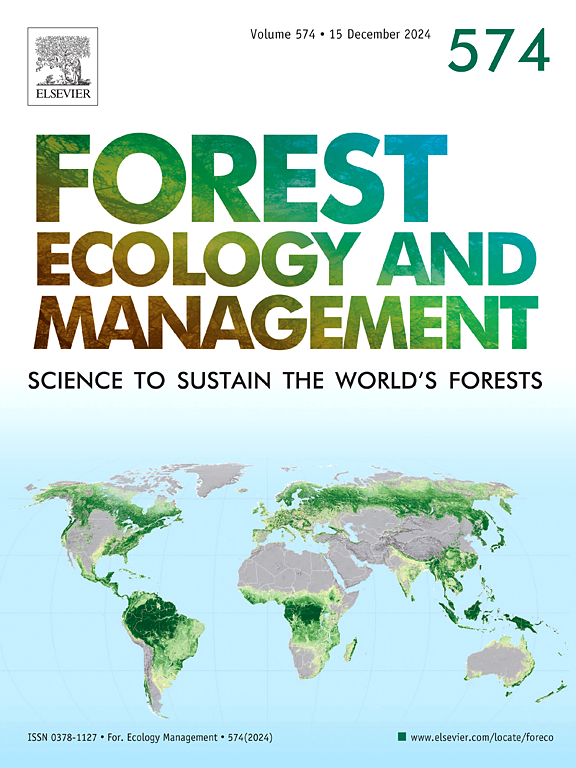桉树人工林有机生物量的去除对真菌网络的影响大于对细菌网络的影响
IF 3.7
2区 农林科学
Q1 FORESTRY
引用次数: 0
摘要
复杂而稳定的土壤微生物网络对人工林的生产力至关重要,但它们对采伐和再植干扰的反应尚不清楚。本研究评估了旨在减轻这些干扰的处理对南非三个桉树人工林土壤微生物生物多样性和网络的影响。我们使用高通量测序方法对108个土壤样品的真菌和细菌生物多样性进行了分类,分为三种处理:(i)保留收获残留物(保留),(ii)去除残留物(去除),(iii)添加肥料去除残留物(施肥)。序列数据的生物信息学和统计学分析揭示了微生物OTU丰富度、网络结构和分类群关联在目水平上的特异性变化。微生物群落丰富度在“保留”样地最高,真菌和细菌群落的处理特异性微生物多样性都很明显。网络比较显示,减轻收获引起的干扰的处理对真菌网络有显著影响,但对细菌网络没有影响。与整个作物被移除的地块相比,“保留”地块的真菌网络表现出最高的复杂性和稳定性。然而,细菌网络在不同处理之间的网络结构没有显着差异。类似的Jaccard指数表明,真菌和细菌结的相关性在三种处理中是一致的。然而,在比较“保留”和“去除”处理时,发现了不同的真菌中心节点。这些发现强调,保留收获残留物可提高微生物丰富度并稳定真菌网络,使其成为比清除残留物或施肥更好的管理土壤扰动的策略。本文章由计算机程序翻译,如有差异,请以英文原文为准。
Removal of organic biomass in Eucalyptus plantations has a greater impact on fungal than on bacterial networks
Complex and stable soil microbial networks are essential for productivity in plantation forestry, but their response to disturbances from harvesting and replanting is not well understood. This study assessed the impact of treatments designed to mitigate these disturbances on microbial biodiversity and networks in Eucalyptus plantation soils at three South African sites. We used high-throughput sequencing to catalogue fungal and bacterial biodiversity from 108 soil samples across three treatments: (i) retention of harvest residues (retained), (ii) removal of residues (removed), and (iii) removal of residues with added fertilizer (fertilized). Bioinformatic and statistical analyses of the sequence data revealed treatment-specific variations in microbial OTU richness, network structure and taxon associations at order-level. Microbiome richness was highest in ‘retained’ plots, and treatment-specific microbial diversity was evident in both fungal and bacterial communities. Network comparisons revealed that treatments to mitigate disturbances caused by harvesting significantly affected fungal networks but not bacterial networks. Fungal networks in ‘retained’ plots exhibited the highest complexity and stability compared to plots where the entire crop was removed. However, bacterial networks did not show significant differences in network structure among treatments. The associations between fungal and bacterial nodes were consistent in the three treatments, as indicated by similar Jaccard indices. However, distinct fungal hub nodes were found when comparing the 'retained' and 'removed' treatments. These findings highlight that retaining harvest residues enhances microbial richness and stabilizes fungal networks, making it a better strategy for managing soil disturbances than residue removal or fertilization.
求助全文
通过发布文献求助,成功后即可免费获取论文全文。
去求助
来源期刊

Forest Ecology and Management
农林科学-林学
CiteScore
7.50
自引率
10.80%
发文量
665
审稿时长
39 days
期刊介绍:
Forest Ecology and Management publishes scientific articles linking forest ecology with forest management, focusing on the application of biological, ecological and social knowledge to the management and conservation of plantations and natural forests. The scope of the journal includes all forest ecosystems of the world.
A peer-review process ensures the quality and international interest of the manuscripts accepted for publication. The journal encourages communication between scientists in disparate fields who share a common interest in ecology and forest management, bridging the gap between research workers and forest managers.
We encourage submission of papers that will have the strongest interest and value to the Journal''s international readership. Some key features of papers with strong interest include:
1. Clear connections between the ecology and management of forests;
2. Novel ideas or approaches to important challenges in forest ecology and management;
3. Studies that address a population of interest beyond the scale of single research sites, Three key points in the design of forest experiments, Forest Ecology and Management 255 (2008) 2022-2023);
4. Review Articles on timely, important topics. Authors are welcome to contact one of the editors to discuss the suitability of a potential review manuscript.
The Journal encourages proposals for special issues examining important areas of forest ecology and management. Potential guest editors should contact any of the Editors to begin discussions about topics, potential papers, and other details.
 求助内容:
求助内容: 应助结果提醒方式:
应助结果提醒方式:


